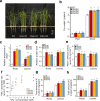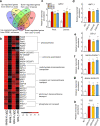Plasma membrane H+-ATPase overexpression increases rice yield via simultaneous enhancement of nutrient uptake and photosynthesis
- PMID: 33531490
- PMCID: PMC7854686
- DOI: 10.1038/s41467-021-20964-4
Plasma membrane H+-ATPase overexpression increases rice yield via simultaneous enhancement of nutrient uptake and photosynthesis
Abstract
Nitrogen (N) and carbon (C) are essential elements for plant growth and crop yield. Thus, improved N and C utilisation contributes to agricultural productivity and reduces the need for fertilisation. In the present study, we find that overexpression of a single rice gene, Oryza sativa plasma membrane (PM) H+-ATPase 1 (OSA1), facilitates ammonium absorption and assimilation in roots and enhanced light-induced stomatal opening with higher photosynthesis rate in leaves. As a result, OSA1 overexpression in rice plants causes a 33% increase in grain yield and a 46% increase in N use efficiency overall. As PM H+-ATPase is highly conserved in plants, these findings indicate that the manipulation of PM H+-ATPase could cooperatively improve N and C utilisation, potentially providing a vital tool for food security and sustainable agriculture.
Conflict of interest statement
The authors declare no competing interests.
Figures






Similar articles
-
Overexpression of a Plasma Membrane H+-ATPase Gene OSA1 Stimulates the Uptake of Primary Macronutrients in Rice Roots.Int J Mol Sci. 2022 Nov 11;23(22):13904. doi: 10.3390/ijms232213904. Int J Mol Sci. 2022. PMID: 36430382 Free PMC article.
-
Revealing the role of the plasma membrane H+-ATPase in plant adaptation to phosphorus deficiency in rice under various nitrogen sources and rhizosphere pH.J Plant Physiol. 2025 Sep;312:154582. doi: 10.1016/j.jplph.2025.154582. Epub 2025 Aug 12. J Plant Physiol. 2025. PMID: 40834754
-
Involvement of plasma membrane H+-ATPase in the nitrate-nutrition uptake and utilization in indica rice.J Plant Physiol. 2024 Dec;303:154368. doi: 10.1016/j.jplph.2024.154368. Epub 2024 Oct 3. J Plant Physiol. 2024. PMID: 39393190
-
Molecular basis of plasma membrane H+-ATPase function and potential application in the agricultural production.Plant Physiol Biochem. 2021 Nov;168:10-16. doi: 10.1016/j.plaphy.2021.09.036. Epub 2021 Sep 29. Plant Physiol Biochem. 2021. PMID: 34607207 Review.
-
Root proteases: reinforced links between nitrogen uptake and mobilization and drought tolerance.Physiol Plant. 2012 May;145(1):165-79. doi: 10.1111/j.1399-3054.2012.01573.x. Epub 2012 Feb 23. Physiol Plant. 2012. PMID: 22242864 Review.
Cited by
-
Overexpression of a Plasma Membrane H+-ATPase Gene OSA1 Stimulates the Uptake of Primary Macronutrients in Rice Roots.Int J Mol Sci. 2022 Nov 11;23(22):13904. doi: 10.3390/ijms232213904. Int J Mol Sci. 2022. PMID: 36430382 Free PMC article.
-
Triiron Tetrairon Phosphate (Fe7(PO4)6) Nanomaterials Enhanced Flavonoid Accumulation in Tomato Fruits.Nanomaterials (Basel). 2022 Apr 13;12(8):1341. doi: 10.3390/nano12081341. Nanomaterials (Basel). 2022. PMID: 35458049 Free PMC article.
-
Paralog editing tunes rice stomatal density to maintain photosynthesis and improve drought tolerance.Plant Physiol. 2023 May 31;192(2):1168-1182. doi: 10.1093/plphys/kiad183. Plant Physiol. 2023. PMID: 36960567 Free PMC article.
-
Effects of Heat Stress on Plant-Nutrient Relations: An Update on Nutrient Uptake, Transport, and Assimilation.Int J Mol Sci. 2023 Oct 27;24(21):15670. doi: 10.3390/ijms242115670. Int J Mol Sci. 2023. PMID: 37958654 Free PMC article. Review.
-
Regulation of Cytosolic pH: The Contributions of Plant Plasma Membrane H+-ATPases and Multiple Transporters.Int J Mol Sci. 2021 Nov 30;22(23):12998. doi: 10.3390/ijms222312998. Int J Mol Sci. 2021. PMID: 34884802 Free PMC article. Review.
References
-
- Marschner, P. Marschner’s Mineral Nutrition of Higher Plants (Elsevier, 2012).
-
- Smil V. Detonator of the population explosion. Nature. 1999;400:415. doi: 10.1038/22672. - DOI
-
- Omar P, Aula L, Oyebiyi F, Raun WR. World cereal nitrogen use efficiency trends: review and current knowledge. Agrosyst. Geosci. Environ. 2019;2:180045.
Publication types
MeSH terms
Substances
LinkOut - more resources
Full Text Sources
Other Literature Sources
Research Materials

